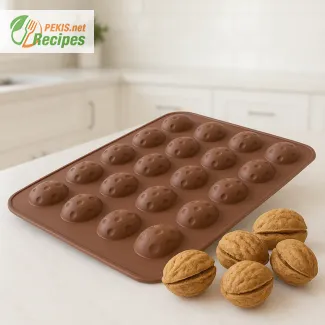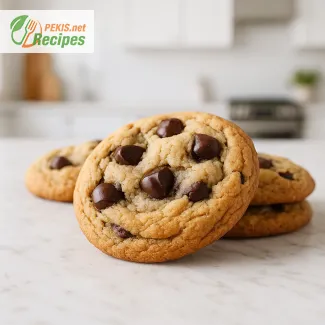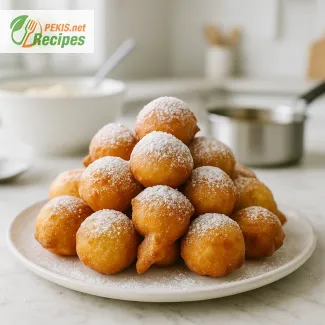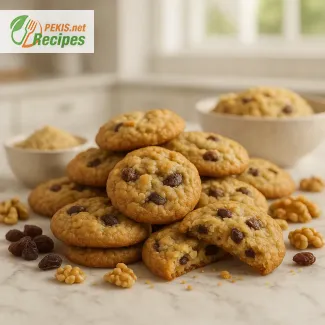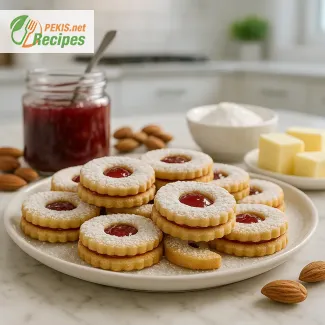
Soft Christmas cookies with white chocolate are a delightful treat that perfectly captures the essence of the holiday season. These cookies, with their rich and creamy texture, offer the perfect balance of sweetness and indulgence, making them an ideal choice for festive gatherings, holiday parties, or as a charming homemade gift. The combination of white chocolate and soft, melt-in-the-mouth dough creates an irresistible dessert that will have everyone reaching for more.
Baking soft Christmas cookies with white chocolate requires attention to detail, but the result is well worth the effort. The buttery dough, complemented by the smooth, decadent sweetness of white chocolate, brings a festive touch to any occasion. Unlike traditional chocolate chip cookies, which are often chewy with a slight crunch, these cookies boast a delicate softness that melts in your mouth, offering a luxurious and comforting experience with each bite.
One of the key features of these cookies is the use of high-quality white chocolate, which not only provides a rich and creamy sweetness but also enhances the flavor profile of the dough. White chocolate, made from cocoa butter, offers a smooth and mild sweetness compared to dark or milk chocolate, allowing it to pair beautifully with the subtle flavors of vanilla and a touch of spices. Whether you use chunks of white chocolate or small chips, the melt-in-the-mouth texture they create is truly unique and adds to the cookie’s overall charm.
In addition to the white chocolate, the softness of these cookies is achieved through a careful balance of ingredients. The key is to use room temperature butter, which helps achieve that light, fluffy texture. Sugar (both granulated and powdered) contributes to the cookie's tender crumb, and the addition of vanilla extract enhances the overall flavor. Baking soda or baking powder provides just the right amount of leavening, ensuring the cookies bake up soft, without being too thick or dense. The combination of these simple ingredients results in a cookie that is both fluffy and moist, yet sturdy enough to hold the delicious chunks of white chocolate.
These cookies are not just about taste – they are also visually appealing. When baked, they develop a slightly golden edge, while the interior remains soft and chewy, with visible chunks of white chocolate creating pockets of sweetness. The subtle shine from the melted chocolate adds a touch of elegance, making these cookies perfect for display on your holiday table.
For those looking to make these cookies even more festive, there are endless ways to customize them. Adding a sprinkle of cinnamon or nutmeg gives the cookies a warm, holiday spice, elevating them to new heights of flavor. Alternatively, you can mix in other seasonal ingredients like cranberries, pecans, or candied orange peel for an extra burst of flavor and color. The possibilities are endless, but the core of this recipe is always the same – soft, buttery, and rich with white chocolate.
These cookies are perfect for holiday baking traditions. They offer a great opportunity to spend quality time in the kitchen with family or friends, making memories while crafting a batch of delightful treats. Whether enjoyed fresh out of the oven with a glass of milk or wrapped up as a gift, these soft Christmas cookies with white chocolate are guaranteed to bring a little extra joy to your celebrations.
Moreover, if you're looking to make these cookies healthier or cater to specific dietary needs, there are simple adjustments that can be made. For those who are gluten-free, swapping out regular flour for a gluten-free flour blend ensures everyone can indulge in this festive treat. Similarly, for those who prefer a lower-sugar version, substituting part of the sugar with a natural sweetener can help reduce the overall sweetness while still maintaining that soft and delicious texture.
The beauty of these Christmas cookies lies not just in their flavor but also in their versatility. Whether served as part of a holiday dessert platter, offered as gifts, or enjoyed as a sweet snack during the colder months, these cookies can fit seamlessly into any part of your holiday celebrations. Their comforting texture, along with the familiar and beloved taste of white chocolate, will make them a favorite at your next holiday gathering.
These cookies are more than just a simple dessert – they’re a reminder of the warmth and joy that comes with the holiday season. They bring together loved ones, create special memories, and leave a lasting impression on all who taste them. With the perfect blend of sweetness, softness, and festive charm, these soft Christmas cookies with white chocolate are destined to become a cherished part of your holiday traditions.
- Prepare the Ingredients: Begin by softening the butter at room temperature. In a large mixing bowl, combine the softened butter with powdered sugar and vanilla extract. Mix until the mixture becomes creamy and smooth. Then, beat in the egg until fully incorporated.
- Add Dry Ingredients: In a separate bowl, combine the flour, baking powder, and salt. Gradually add the dry ingredients to the butter mixture, mixing until everything is well combined and a soft dough forms.
- Incorporate White Chocolate: Chop the white chocolate into small chunks or use pre-chopped white chocolate. Add the chocolate pieces to the dough and mix gently until evenly distributed throughout the dough. If the dough is too sticky, add a small amount of flour.
- Shape the Cookies: Using your hands or a cookie scoop, form the dough into small balls and place them onto a baking sheet lined with parchment paper. Lightly press the dough balls to flatten them slightly. Leave some space between the cookies as they will spread slightly during baking.
- Bake the Cookies: Preheat your oven to 180°C (160°C for fan ovens). Bake the cookies for 10-12 minutes, or until they turn golden around the edges. The cookies will continue to firm up as they cool, so be careful not to overbake them.
- Decoration (optional): If desired, melt the remaining milk white chocolate and drizzle it over the cooled cookies for added decoration. Allow the chocolate to set before serving.
Baking soft Christmas cookies with white chocolate is a festive tradition that brings both flavor and warmth to any holiday celebration. While the basic recipe offers a delightful starting point, several factors and adjustments can elevate the taste, texture, and appearance of the cookies, ensuring they are absolutely perfect for your holiday gathering. Below, we’ll explore a variety of tips and tricks that can help improve this recipe, offering you flexibility in flavor, texture, and dietary preferences. By experimenting with these tips, you can fine-tune the recipe to match your exact needs and preferences.
1. Choosing the Right Ingredients
The quality of ingredients is the foundation of any great cookie recipe, and it’s especially important when baking cookies with delicate flavors like white chocolate. Here’s how you can choose the best ingredients to ensure your cookies turn out perfect every time:
- Butter: Using unsalted butter is essential in cookie recipes. Salted butter can alter the balance of flavors, making your cookies too salty. Make sure your butter is softened to room temperature to allow for easy mixing and a smoother dough. If you’re looking to enhance the richness of the cookies, consider using European-style butter, which has a higher fat content, making the cookies more tender and flavorful.
- White Chocolate: Not all white chocolate is created equal, and the quality of the white chocolate you use will greatly impact the flavor of your cookies. Opt for a high-quality white chocolate that contains a higher percentage of cocoa butter. Cheaper, lower-quality white chocolates tend to have a waxy texture and may lack the creamy richness that is key to great cookies. If you prefer, you can also experiment with adding white chocolate chips or chopped white chocolate chunks instead of using bar-style chocolate. This ensures a more uniform melt in your dough and can offer a more consistent distribution of chocolate.
- Sugar: A combination of granulated sugar and powdered sugar is ideal for this recipe. The granulated sugar gives the cookies a crisp edge, while the powdered sugar contributes to their soft, melt-in-the-mouth texture. If you prefer a more subtle sweetness, you can reduce the amount of sugar or substitute some of it with honey or maple syrup for a more natural sweetness.
2. Adjusting Texture: How to Make Your Cookies Softer or Crispier
The texture of these cookies is largely determined by the ratio of fat, sugar, and flour. If you desire a softer, more chewy texture, here are a few ways to adjust the dough:
- Increase the fat content: Adding a little more butter can make the dough softer and produce a more chewy, tender cookie. Just be mindful not to add too much, as it may make the cookies overly greasy.
- Flour adjustment: Using too much flour can result in a dense, dry cookie. On the other hand, using too little flour can lead to cookies that spread too much and become overly thin. The key is to measure your flour accurately—using a digital scale to weigh your flour will ensure you use the correct amount. If your dough seems too dry, you can add a teaspoon of milk or water to bring it together.
- Resting the dough: Letting the cookie dough rest for at least 30 minutes in the refrigerator before baking helps to hydrate the flour, resulting in a smoother dough and a softer cookie. Additionally, chilling the dough can help reduce spreading during baking, which is especially useful if you prefer your cookies to retain their shape.
- Baking time and temperature: Baking your cookies at the right temperature ensures they bake evenly. If you like your cookies crispy on the edges but soft in the center, bake them at 180°C (350°F) for a shorter time (around 10-12 minutes). For a slightly crispier cookie, extend the baking time by an additional 2-3 minutes. Be sure to check them toward the end of the baking time, as ovens can vary.
3. Flavor Enhancements and Additions
While the white chocolate itself brings plenty of sweetness and richness, there are numerous ways to elevate the flavor profile of these cookies, adding complexity and depth to the overall taste:
- Vanilla Extract: Vanilla is a classic complement to white chocolate, and it enhances the overall flavor of the cookie. You can experiment with different types of vanilla—pure vanilla extract offers a natural flavor, while vanilla bean paste provides a more intense vanilla aroma with visible flecks of real vanilla bean. If you want to add a twist, try almond extract or a dash of citrus zest (like orange or lemon) for a refreshing, aromatic layer of flavor.
- Spices: Adding a pinch of cinnamon, nutmeg, or ginger can introduce a cozy, spicy warmth to your cookies, making them even more perfect for the winter holidays. A small amount of cloves or allspice can also provide a deeper, more robust flavor that pairs beautifully with white chocolate.
- Nuts and Dried Fruits: For extra texture and flavor, consider adding chopped nuts (like pecans, walnuts, or hazelnuts) or dried fruits (such as cranberries, raisins, or cherries). These add both color and a subtle contrast to the sweet, creamy white chocolate.
4. Making Dietary Adjustments
This white chocolate cookie recipe can easily be adapted to fit various dietary needs without sacrificing flavor or texture:
- Gluten-Free Options: To make the cookies gluten-free, swap out the all-purpose flour with a gluten-free flour blend. If you don’t have a pre-made blend, you can combine rice flour, potato starch, and a little xanthan gum for the right consistency. The key is ensuring the dough holds together without being too crumbly or too soft.
- Dairy-Free or Vegan Options: If you need a dairy-free or vegan version of these cookies, substitute the butter with vegan butter or coconut oil, and use a plant-based milk (like almond milk) to adjust the dough's consistency if necessary. For the white chocolate, opt for dairy-free white chocolate or make your own by using coconut butter, powdered sugar, and vanilla. To replace the egg, try using flaxseed meal or chia seeds mixed with water to form a gel-like texture (often referred to as a "flax egg" or "chia egg").
- Lower Sugar Version: For those watching their sugar intake, you can replace the sugar in this recipe with natural sweeteners like stevia, monk fruit sweetener, or erythritol. Just keep in mind that different sweeteners have different levels of sweetness, so adjust accordingly. You may need to add a little more moisture (like unsweetened applesauce) to compensate for any dryness.
5. How to Decorate and Store Your Cookies
The appearance of these cookies can be just as important as their taste, especially during the holidays when presentation matters:
- Decorating Your Cookies: While optional, decorating these cookies with a drizzle of melted white chocolate adds a beautiful glossy finish. For an extra touch, you can sprinkle some colored sugar or edible glitter over the cookies. If you're making these cookies for a gift, wrapping them up in a cellophane bag tied with a festive ribbon adds a personal, thoughtful touch.
- Storage Tips: To keep your cookies soft and fresh, store them in an airtight container at room temperature. If you need to store them for a longer period, you can freeze them. Just make sure to wrap the cookies well in plastic wrap or wax paper before placing them in a freezer-safe container. When you're ready to serve them, simply thaw at room temperature for the freshest taste.
6. Final Thoughts
By carefully adjusting the ingredients and following these tips, you can make your soft Christmas cookies with white chocolate truly spectacular. Whether you’re baking for a crowd or preparing a batch to share with loved ones, these tips will help you refine the recipe to match your tastes and dietary preferences. Each batch of cookies you bake will be better than the last, as you fine-tune the balance of flavor, texture, and appearance. With a bit of creativity and attention to detail, these cookies will undoubtedly become a favorite holiday tradition in your household for years to come.
- Allergens present:
- Dairy (in butter and white chocolate)
- Eggs
- Gluten (in flour)
Substitute Ingredients for Allergy and Gluten-Free Options:
- For gluten-free cookies: Replace regular flour with a gluten-free flour blend or a combination of rice flour and cornstarch. Add xanthan gum or guar gum to improve the texture and prevent crumbling.
- For dairy-free cookies: Use dairy-free butter or coconut oil and substitute the white chocolate with dairy-free white chocolate.
- For egg-free cookies: Use a flax egg or chia egg (1 tbsp ground flaxseed or chia seeds mixed with 3 tbsp water, let sit for 5 minutes until it forms a gel-like consistency).
- Vitamin A (from butter): Essential for maintaining healthy vision, skin, and immune system function.
- Vitamin E (from butter): Acts as a powerful antioxidant, protecting cells from oxidative damage.
- Calcium (from dairy ingredients): Important for building and maintaining strong bones and teeth.
- Magnesium (from white chocolate): Supports muscle and nerve function, as well as bone health.
- Polyphenols (from white chocolate): Provide strong antioxidant effects, helping reduce oxidative stress and inflammation in the body.
- Flavonoids (from white chocolate): Play a role in improving cardiovascular health by promoting blood circulation and reducing blood pressure.
